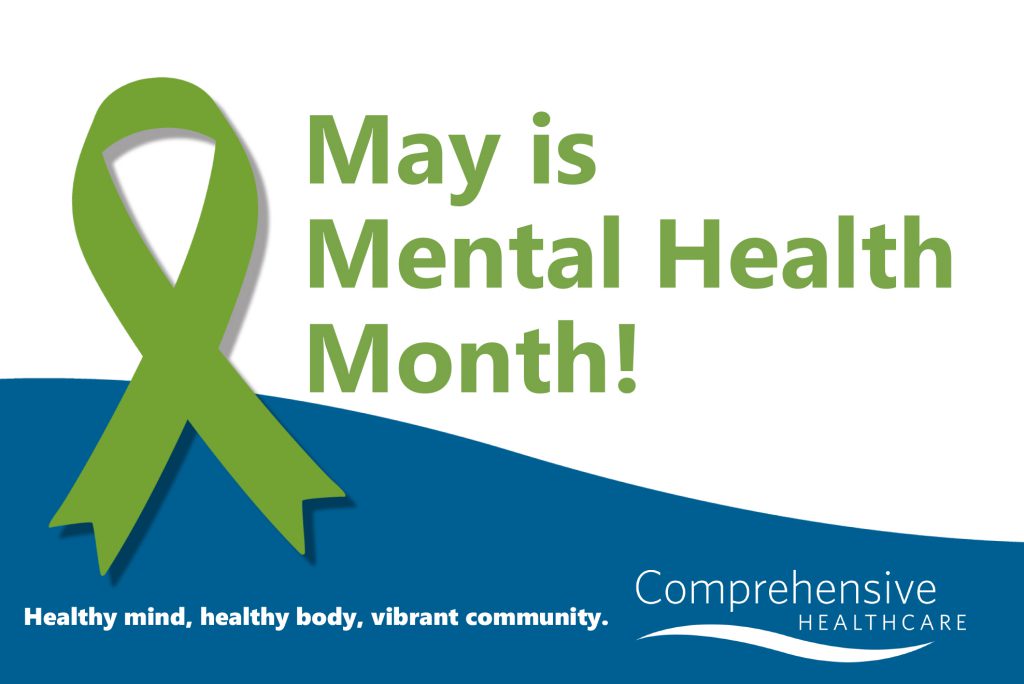One in five individuals will be diagnosed with a mental health disorder in their lifetime. In Washington State, that number reflects one in four. Mental illnesses are common in the United States, affecting tens of millions of people each year. An equally concerning fact is that only half of people with a mental illness seek and receive treatment. Furthermore, data indicators that assess whether or not state and federal initiatives are impacting the mental health of our communities show Washington State to be ranked at 46 out of 51. This means that Washington State has a high prevalence of mental illness and lower rate of access to care.
This year, Mental Health of America launched the campaign, You Are Not Alone. Comprehensive Healthcare is supporting that campaign, and wants everyone who is struggling with mental health or substance use to know that they are not alone. Comprehensive Healthcare is joining in the campaign by sharing messages of hope, and raising awareness of the many resources and services available to individuals through Comprehensive Healthcare. They are hosting virtual events, putting up banners at each of their facilities and sharing client stories. Comprehensive Healthcare also recently released their new tagline: Healthy mind, healthy body, vibrant community. The intent of this phrase is to illustrate how mental health contributes to physical health and well-being, and both are essential for individuals to live positive, healthy lives.
The COVID-19 pandemic has only increased the need to raise awareness for mental health, according to Jodi Daly, Ph.D., President and CEO of Comprehensive Healthcare. “In the coming months, it has been forecasted that there will be increased need for mental health services because of the implications that COVID-19 has had on our communities,” said Daly. The social, emotional, and financial impacts of COVID-19 will place additional stressors on Washington State’s behavioral health system – a system that already struggles to meet the needs of individuals facing behavioral health challenges. The system’s inability to meet the growing demand for behavioral healthcare include a number of key factors such as a workforce shortage of qualified behavioral healthcare providers coupled with inadequate funding and unnecessary administrative burdens. Daly believes that now is the time to be proactive and prepare for a surge in demand for services that will most likely include a prevalence of grief, depression and anxiety disorders due to the multiple economic and social impacts of the COVID-19 pandemic.
A more urgent matter, preliminary data indicates that deaths by suicide in some counties in south-central Washington State have increased when compared to last year, while calls to Comprehensive Healthcare’s designated crisis response professionals have decreased. “It is clear that discussions about behavioral health need to take place well before a crisis occurs. Our friends and family members need to understand that seeking help from a behavioral health provider when they are feeling sad or depressed is just as essential as seeing a medical doctor for a broken bone,” said Daly.
The barriers to receiving behavioral healthcare can include finances, feeling too busy or not having enough time, living far away from resources, not having quick access to a provider, or simply not knowing where to find help. Daly says, however, the most harmful barrier to accessing mental health services is stigma. “Stigma is a form of discrimination that pervades the lives of people so significantly that it can deprive them of adequate healthcare, education and employment opportunities.” Stigma associated with mental illness is a contributing factor to many disparities as it relates to equity of resources. The key to effectively eliminating mental illness will be to decrease and eliminate stigma.
Advances in biology, psychology, and genetics have contributed to more effective treatments for behavioral health disorders. As a result, there have been advancements in medical treatments, telehealth technology has improved access for individuals in rural areas, and insurance plans have extended coverage to include mental health and substance use treatment. However, Daly says there is still work to be done. “Our current system adversely impacts our community by shortening the lifespan of those who suffer from mental health challenges due to excess medical comorbidity, and increased suicide and overdose rates.”
Treatment services can help individuals to not only become healthier, but also allow people to find jobs, remain out of the criminal justice system, graduate from high school or college, avoid repeated hospital visits, and lead healthy and successful lives. Behavioral health recovery is different for each individual. However, the dimensions of recovery include living a healthy life, securing a safe place to live and call home, discovering a sense of purpose and becoming an engaged community member.



